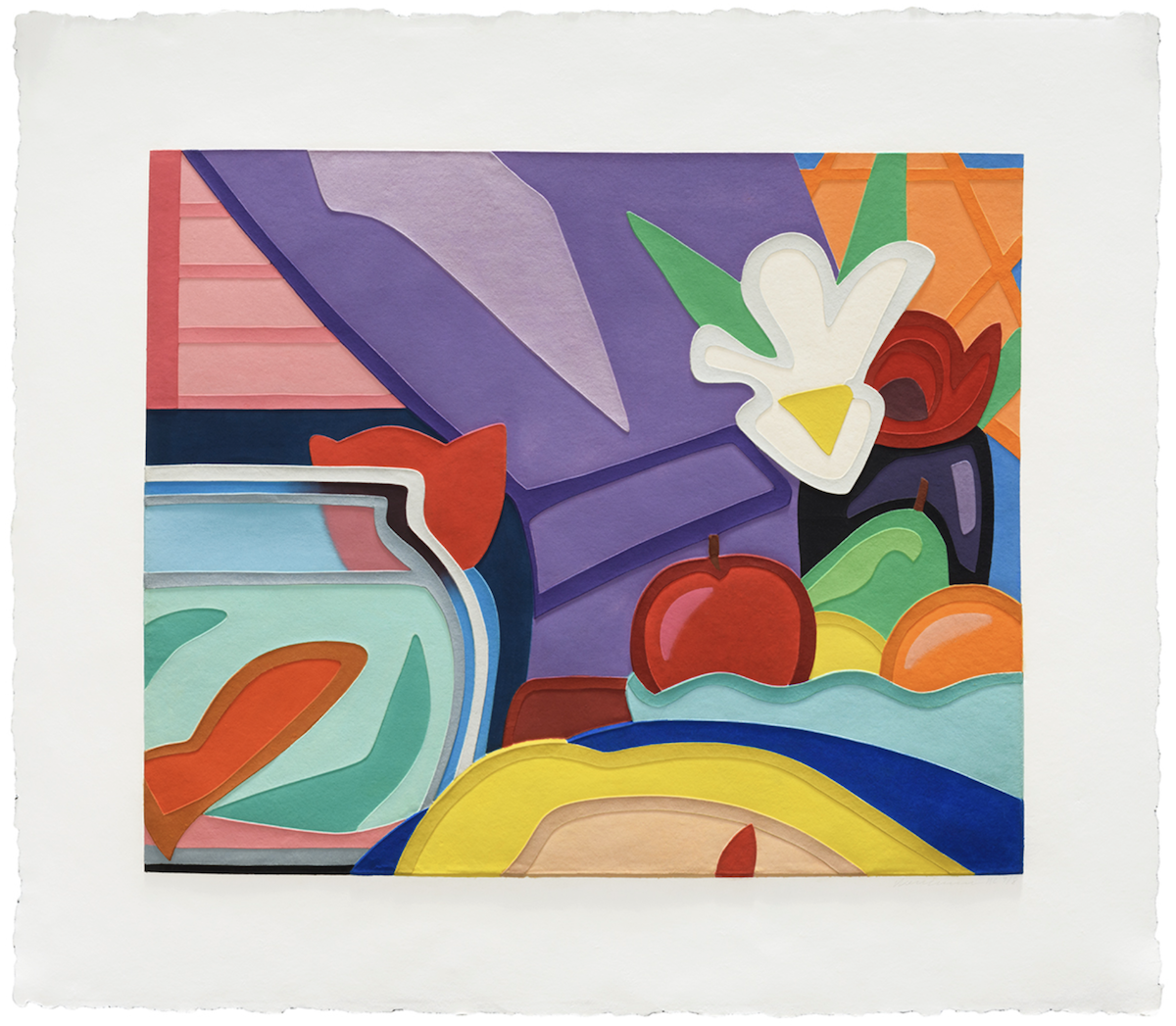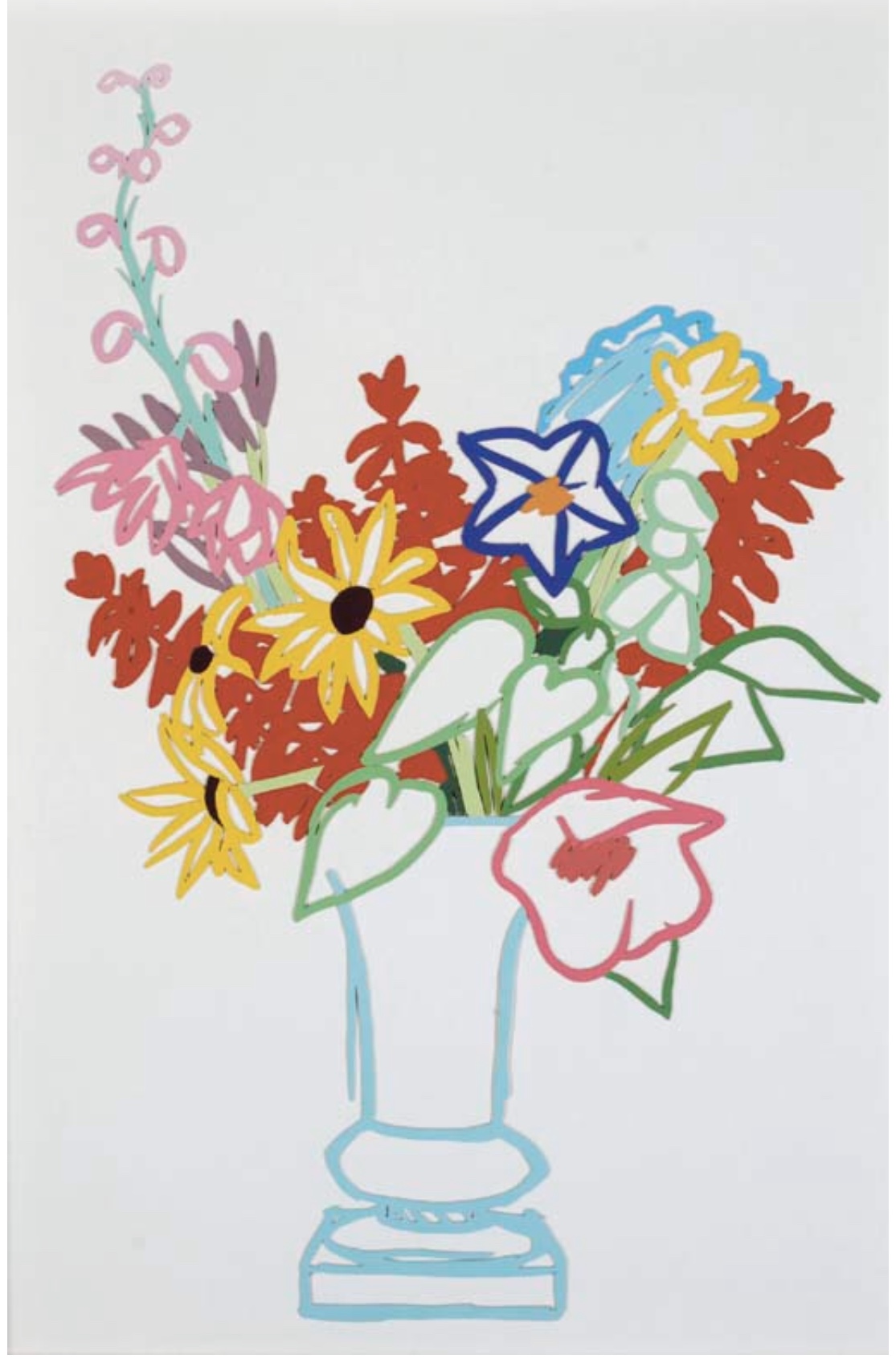Tom Wesselmann – Still Life with Blonde and Goldfish
Tom Wesselmann, Still Life with Blonde and Goldfish is a mixografia print on handmade paper. This print is pencil signed and numbered from the edition of 75 in the lower right.
One of the leading American Pop artists of the 1960s, Tom Wesselmann rejected abstract expressionism in favor of classical representations of the nude, still life, and landscape. He created collages and assemblages incorporating everyday objects and advertising ephemera in an effort to make images as powerful as the abstract expressionism he admired. He is perhaps best known for his “Great American Nude” series with its sensuous forms and intense colors. In the 1970s, Wesselmann continued to explore the ideas and media which had preoccupied him during the decade prior. The 1990s and early 2000s saw the artist expanding on these themes, creating abstract three-dimensional images that he described as “going back to what I had desperately been aiming for in 1959.” He had indeed come full circle.
Wesselmann took part in the New Realist show with some reservations, exhibiting two 1962 works: Still life #17 and Still life #22. Wesselmann never liked his inclusion in American Pop Art, pointing out how he made an aesthetic use of everyday objects and not a criticism of them as consumer objects: “I dislike labels in general and ‘Pop’ in particular, especially because it overemphasizes the material used. There does seem to be a tendency to use similar materials and images, but the different ways they are used denies any kind of group intention”.
That year, Wesselmann had begun working on a new series of still lifes. experimenting with assemblage as well as collage. In Still Life #28 he included a television set that was turned on, “interested in the competitive demands that a TV, with moving images and giving off light and sound, can make on painted portions”. He concentrated on the juxtapositions of different elements and depictions, which were at the time truly exciting for him: “Not just the differences between what they were, but the aura each had with it… A painted pack of cigarettes next to a painted apple wasn’t enough for me. They are both the same kind of thing. But if one is from a cigarette ad and the other a painted apple, they are two different realities and they trade on each other… This kind of relationship helps establish a momentum throughout the picture… At first glance, my pictures seem well behaved, as if – that is a still life, O.K. But these things have such crazy give-and-take that I feel they get really very wild”.
| Title | Still Life with Blonde and Goldfish |
|---|---|
| Medium | Mixograph |
| Year | 2000 |
| Edition | 75 |
| Signature | Signed, numbered |
| Size | 33.25 x 39 (in) 84 x 99 (cm) |
| Price | SOLD |
Description
Tom Wesselmann, Still Life with Blonde and Goldfish is a mixografia print on handmade paper. This print is pencil signed and numbered from the edition of 75 in the lower right.
One of the leading American Pop artists of the 1960s, Tom Wesselmann rejected abstract expressionism in favor of classical representations of the nude, still life, and landscape. He created collages and assemblages incorporating everyday objects and advertising ephemera in an effort to make images as powerful as the abstract expressionism he admired. He is perhaps best known for his “Great American Nude” series with its sensuous forms and intense colors. In the 1970s, Wesselmann continued to explore the ideas and media which had preoccupied him during the decade prior. The 1990s and early 2000s saw the artist expanding on these themes, creating abstract three-dimensional images that he described as “going back to what I had desperately been aiming for in 1959.” He had indeed come full circle.
Wesselmann took part in the New Realist show with some reservations, exhibiting two 1962 works: Still life #17 and Still life #22. Wesselmann never liked his inclusion in American Pop Art, pointing out how he made an aesthetic use of everyday objects and not a criticism of them as consumer objects: “I dislike labels in general and ‘Pop’ in particular, especially because it overemphasizes the material used. There does seem to be a tendency to use similar materials and images, but the different ways they are used denies any kind of group intention”.
Tom Wesselmann Still Life with Blonde and Goldfish
That year, Wesselmann had begun working on a new series of still lifes. experimenting with assemblage as well as collage. In Still Life #28 he included a television set that was turned on, “interested in the competitive demands that a TV, with moving images and giving off light and sound, can make on painted portions”. He concentrated on the juxtapositions of different elements and depictions, which were at the time truly exciting for him: “Not just the differences between what they were, but the aura each had with it… A painted pack of cigarettes next to a painted apple wasn’t enough for me. They are both the same kind of thing. But if one is from a cigarette ad and the other a painted apple, they are two different realities and they trade on each other… This kind of relationship helps establish a momentum throughout the picture… At first glance, my pictures seem well behaved, as if – that is a still life, O.K. But these things have such crazy give-and-take that I feel they get really very wild”.
Tom Wesselmann, Still Life with Blonde and Goldfish
Additional information
| Title | Still Life with Blonde and Goldfish |
|---|---|
| Medium | Mixograph |
| Year | 2000 |
| Edition | 75 |
| Signature | Signed, numbered |
| Size | 33.25 x 39 (in) 84 x 99 (cm) |
| Price | SOLD |







